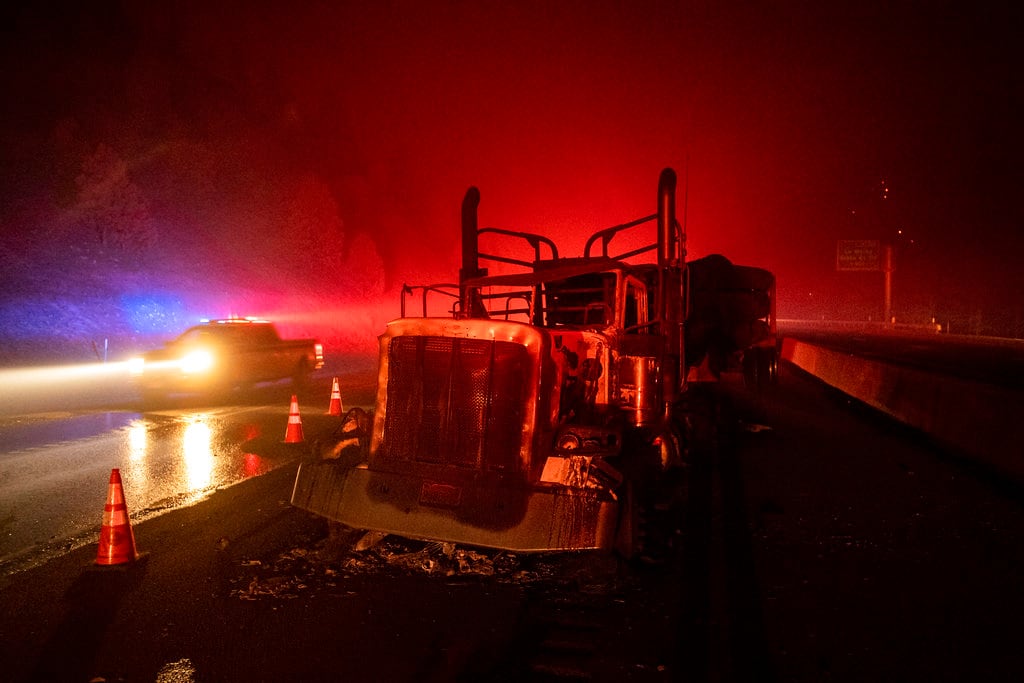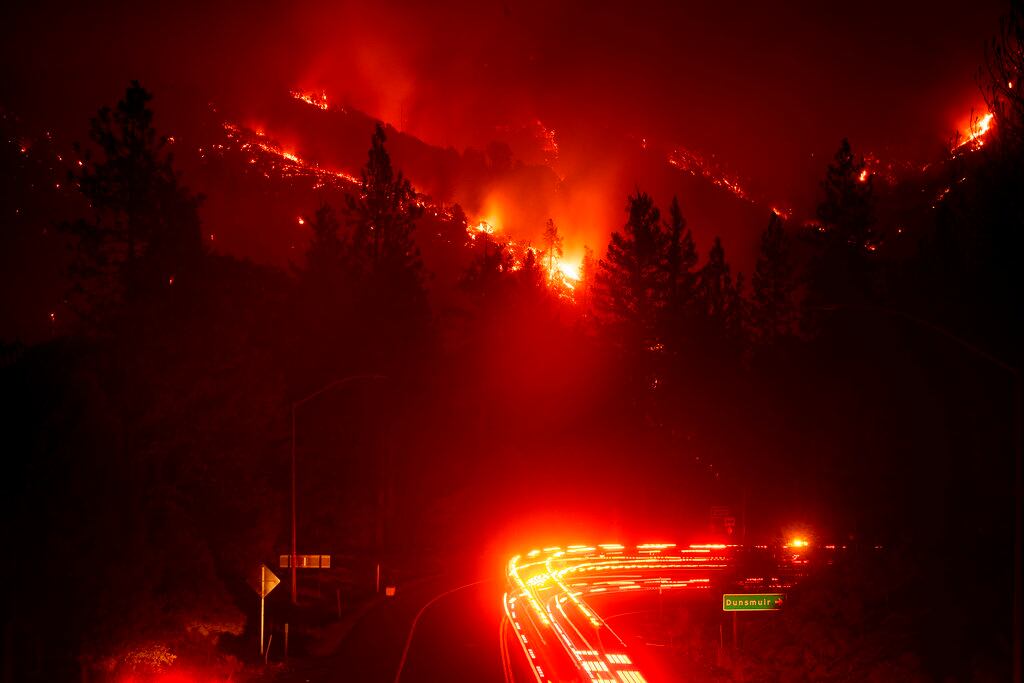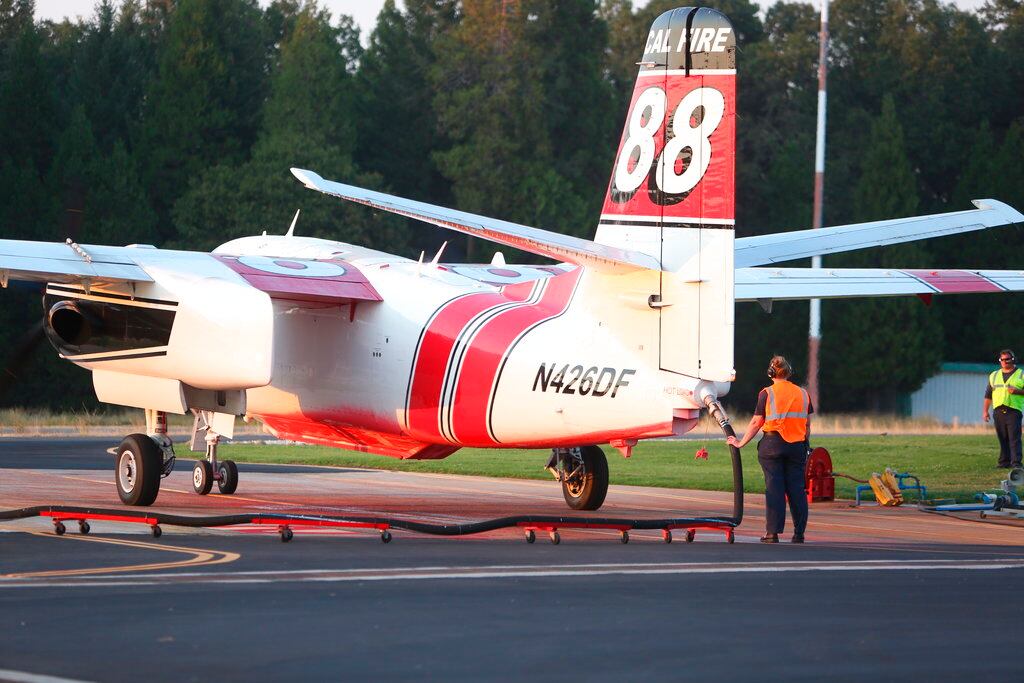REDDING, Calif. — The Latest on wildfires burning in California (all times local):
11:15 a.m.
A forest fire raging in Sierra Nevada has grown to more than 7 square miles (18 square kilometers) after shutting down a major highway along the eastern spine of California and forcing the evacuation of a military base.
The fire was only 3 percent contained Thursday morning after a day of fire behavior described as extreme and erratic.
The Marine Corps Mountain Warfare Training Center, campgrounds and other areas were evacuated Wednesday. Ranchers were told to prepare to move livestock out of the area.
The fire has closed stretches of U.S. 395, State Route 108 and the Pacific Crest Trail.
The fire in the Humboldt-Toiyabe National Forest is one of several burning in California.
Several hundred miles to the northwest, a fire in the Shasta-Trinity National Forest grew after raging across vital Interstate 5. It forced truckers and motorists to abandon vehicles and flee Wednesday afternoon.

10:55 a.m.
California's insurance commissioner says victims of the state's two largest wildfires this year have filed more than 10,000 claims so far totaling $845 million.
Commissioner David Jones said Thursday that the two Northern California fires destroyed or damaged a combined 8,800 homes and 329 businesses.
The fires also damaged 800 vehicles and caused other property damage.
A spark from a flat tire started a fire near Redding that killed eight people. The Mendocino Complex Fire destroyed property in three counties.
Jones previously said insurers received 45,000 claims totaling more than $11.8 billion for damage from wildfires in 2017.

8:20 a.m.
The only interstate highway connecting Oregon to California is still closed as a fire burns on both sides of it in California.
California Highway Patrol Officer Jason Morton says officials from different agencies will meet Thursday to determine if they can reopen the highway, which is a key route for commercial trucks.
About 45 miles (72 kilometers) of Interstate 5 were closed in both directions north of the city of Redding and south of Mount Shasta in the Shasta-Trinity National Forest.
The highway runs from the U.S.-Mexico border through California, Oregon and Washington state to the U.S-Canada border.
Lt. Cmdr. Kyle Foster of the California Highway Patrol told the Los Angeles Times about 17 big rigs were abandoned on the stretch of closed highway and at least four caught fire.

7:10 a.m.
Fire officials say a wildfire roaring through timber and brush on both sides of a Northern California highway tripled in size overnight, prompting mandatory evacuations.
The U.S. Forest Service said Thursday the blaze burning along Interstate 5 near Redding had grown to 23 square miles (60 square kilometers). It was 8 square miles (21 square kilometers) on Wednesday.
Officials did not immediately say how many people the evacuation order affected. The fire is in a rural area with scattered homes.
Officials said the blaze was human-caused but they didn't indicate whether it was arson or accident.
Truckers abandoned their vehicles as flames roared up hillsides. Officials say about 17 big-rigs were abandoned and at least four caught fire.
A wildfire nearby that was only contained last week left neighborhoods in ruins and killed eight people.
RELATED
Bomb the fires!
12:00 a.m.
Abandoned trucks are scattered along a section of a major California freeway, which closed after a wildfire exploded near Redding.
The fire erupted Wednesday and has roared through timber and brush on both sides of Interstate 5 near the Oregon state line.
Fire officials say the blaze was human-caused, shut down about 45 miles (72 kilometers) of the freeway and there's no word when it will reopen.
California Highway Patrol Lt. Cmdr. Kyle Foster tells the Los Angeles Times that truckers abandoned 17 big-rigs as flame raged next to the freeway, and at least four rigs caught fire.
Evacuations were ordered for scattered homes and cabins in and around the Shasta-Trinity National Forest.
But while the fire was moving rapidly, fire officials say it doesn’t immediately threaten any large towns.





